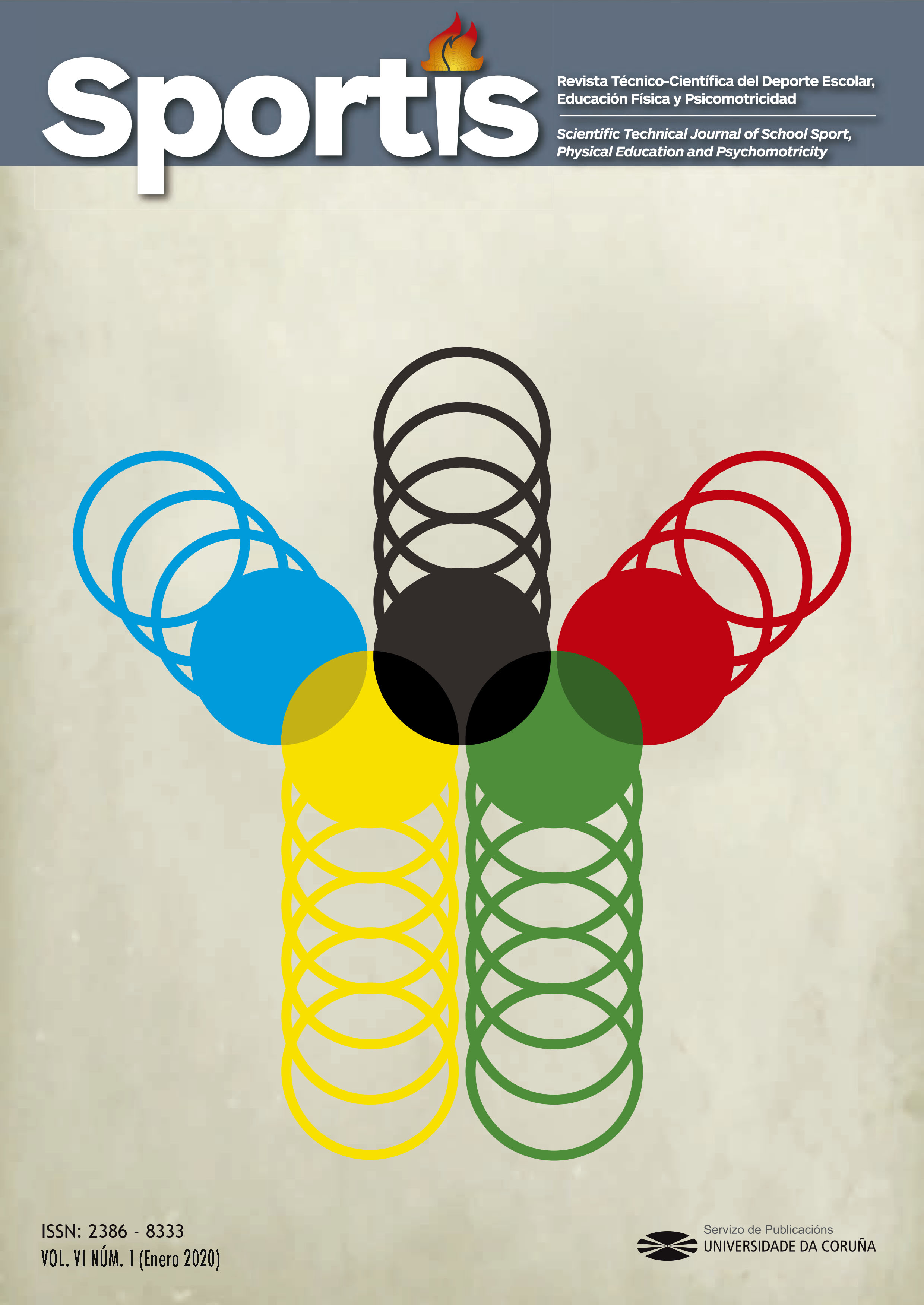Physical fitness, rating perceived exertion and academic performance in primary school
Main Article Content
Abstract
There are studies in which it has been possible to establish a relationship between the cognitive and academic performance of students and their levels of physical condition. The objectives of this research are to study the correlation between the physical fitness level and body composition with the academic performance, as well as to analyze the correlation between such variables and the Rating of Perceived Exertion (RPE) of elementary school students by gender. A total of 69 primary school students participated in the study (age= 12.33±0.47 years, 55.9% girls and 44,1% boys). The physical fitness and body composition were evaluated according to the ALPHA Fitness test Battery for children and adolescents. The academic performance was studied by means of the average of notes of the instrumental subjects of primary education. The RPE was recorded in PE classes and school physical activities by using the Borg RPE scale (0-10). Significant correlations were established between the RPE and the weight of the boys (r= 0,406, p= 0.02) and girls (r= 0,643, p< 0.001) and also with respect to the BMI, boys (r= 0,508, p= 0.004), girls (r= 0,621, p< 0.001). There was a significant negative correlation between the Course Navette test and the RPE in the case of boys (r= -0,633, p< 0.001) and girls (r= -0,452, p= 0.004). The RPE correlated significantly with the stages of the Course Navette test (inverse correlation) and with the body composition variables, such as weight and BMI.
Keywords:
Downloads
Article Details
References
Abellán, J., Sáez, N. Mª., Reina, R., Ferriz, R., y Navarro, R. (2019). Percepción de autoeficacia hacia la inclusión de futuros maestros de educación física. Revista de Psicología del Deporte, 28(2), 134-146. Recuperado de: https://www.researchgate.net/profile/Ruben_Navarro_Paton/publication/330567114_Percepcion_de_autoecacia_hacia_la_inclusion_en_futuros_maestros_de_educacion_fisica/links/5c48d47392851c22a38c1243/Percepcion-de-autoecacia-hacia-la-inclusion-en-futuros-maestros-de-educacion-fisica.pdf
Beregüi, R., Garcés de los Fayos, E. (2007). Valores en el deporte escolar: estudio con profesores de educación física. Cuadernos de Psicología del Deporte, 7(2), 89-104. Recuperado de: http://revistas.um.es/cpd/article/view/54621
Brito, Mª.E., Ruiz, J.A., Navarro, M., García J.M. (2009). Valoración de la condición física y biológica en escolares. Sevilla: Wanceulen editorial deportiva.
Cancela, J.M., Ayan, C., Sanguos, M.J. (2016) Relación entre la condición física y rendimiento académico en matemáticas y lenguaje en estudiantes españoles en educación secundaria: un estudio longitudinal. CCD. Cultura_Ciencia_Deporte, 11(31), 7-16. Recuperado de: http://ccd.ucam.edu/index.php/revista/article/view/638 DOI: https://doi.org/10.12800/ccd.v11i31.638
Castro, R., Pérez, V. Cachón, J., Zagalaz, Mª.L. (2016) Valoración de la relación entre rendimiento académico y condición física en escolares. Revista Euroamericana de Ciencias del Deporte, 5(1), 47-54. Recuperado de: https://revistas.um.es/sportk/article/download/249111/189371/0. DOI: https://doi.org/10.6018/249111
Cuadrado, J. (2010). Análisis de la influencia de la intensidad del entrenamiento sobre variables de control de la carga interna en deportes colectivos. (Tesis doctoral, Universidad de Granada). Recuperado de http://digibug.ugr.es/handle/10481/5574
Duran, S., Valdés, P., Godoy, A. y Herrera, T. (2014) Hábitos alimentarios y condición física en estudiantes de pedagogía en educación física. Revista chilena de nutrición. 43 (3) 251-259. DOI: https://doi.org/10.4067/S0717-75182014000300004
Dwyer, T., Sallis, J. F., Brizar, L., Lazarus, R. & Deán, K. (2001). Relation of Academic Performance to Physical Activity and Fitness in Children. Pediatric Exercise Science, 13, 225-238. Retrieved from http://www.sparkpe.org/wp-content/uploads/2010/03/Relation-of-Academic-Performance-to-P-A-and-Fitness-in-Children.pdf. DOI: https://doi.org/10.1123/pes.13.3.225
Estrada, Mª.M. (2017) Estudio descriptivo sobre el abandono escolar temprano e influjo de variables personales y socio-culturales en la ciudad autónoma de Melilla. (Tesis doctoral, Universidad de Granada). Recuperado de: http://digibug.ugr.es/handle/10481/46812
Gálvez-Casas, A., Rodríguez García, P. L., García-Cantó, E., Rosa Guillamón, A., Pérez-Soto, J. J., Marcos, L. T., y López, P. T. (2015). Capacidad aeróbica y calidad de vida en escolares de 8 a 12 años. Clínica e Investigación en Arteriosclerosis, 27(5), 239-245. DOI: https://doi.org/10.1016/j.arteri.2015.01.001
Guillamón, A. R., Canto, E. G., y López, P. J. C. (2019). Capacidad aeróbica y rendimiento académico en escolares de educación primaria. Retos: nuevas tendencias en educación física, deporte y recreación, (35), 351-354.
Linder, K. (1999). Sport Participation and Perceived Academic Performance of School Children and Youth. Pediatric Exercise Science, 11, 129-144. DOI: https://doi.org/10.1123/pes.11.2.129
López, F.J., Lara, A.J., Espejo, N. y Cachón, J. (2016) Influencia del género la edad y el nivel de actividad física en la condición física de alumnos de educación primaria. Revisión bibliográfica. Retos: nuevas tendencias de educación física, deporte y recreación, 29, 129-133. Recuperado de: https://dialnet.unirioja.es/servlet/articulo?codigo=5400858
Pertusa, G., Sanz-Frías, D., Salinero, J. J., Pérez-González, B., y García-Pastor, T. (2018). Rendimiento académico y su relación con niveles de actividad física y de condición física en adolescentes. Revista de psicología del deporte, 27(1), 125-130.
Prat, G., & Prat, S. (2003). Actitudes valores y normas en educación física y el deporte, Barcelona, España, INDE Publicaciones.
Ruiz, J. R., España Romero, V., Castro Piñero, J., Artero, E. G., Ortega, F. B., Cuenca García, M., Castillo, M. J. (2011). Batería ALPHA-Fitness: test de campo para la evaluación de la condición física relacionada con la salud en niños y adolescentes. Nutrición Hospitalaria, 26(6). Recuperado de: http://scielo.isciii.es/pdf/nh/v26n6/03_articulo_especial_02a.pdf
Sanmartín, M. G. (2004). El valor del deporte en la educación integral del ser humano. Revista de educación, 335, 105-126. Recuperado de: http://www.revistaeducacion.educacion.es/re335/re335_10.pdf
Solís, P., Borja, V. (2019). Niveles de actividad física y sedentarismo en escolares de 3º y 4º de educación primaria. EmasF: revista digital de educación física, (56), 119-131. Recuperado de: https://dialnet.unirioja.es/servlet/articulo?codigo=6751147
Teixeira, C., Kalinoski, S. (2003). La importancia del deporte como factor social en las matrículas en escuelas deportivas de la administración pública de Pindamonhangaba, Brasil. Efdeportes, Revista Digital 9 (60). Recuperado de: http://www.efdeportes.com/efd60/social.htm
Tremblay, M.S., Inman, J.W. Willms J.D. (2000). The relationship between physical activity, self-esteem, and academic achievement in 12-year-old children. Pediatric Exercise Science, 12, 312-323. DOI: https://doi.org/10.1123/pes.12.3.312






